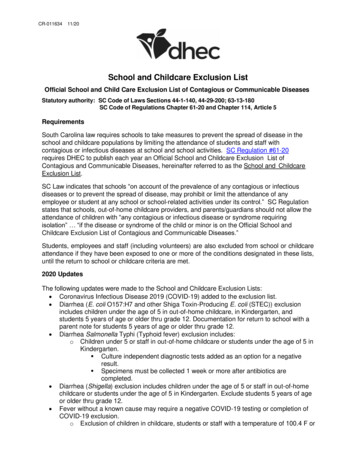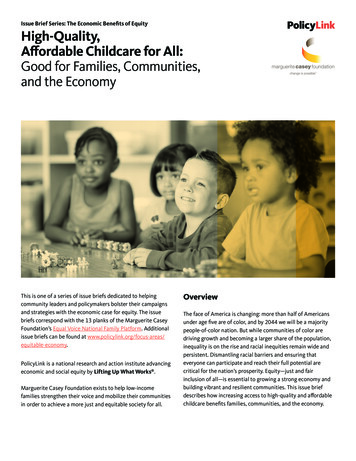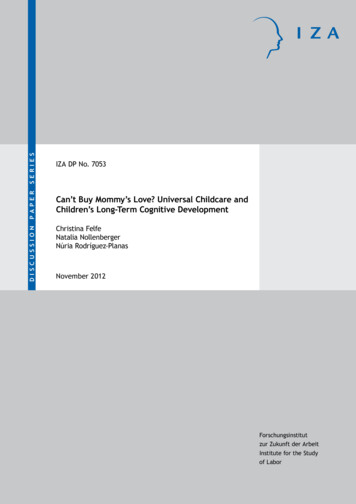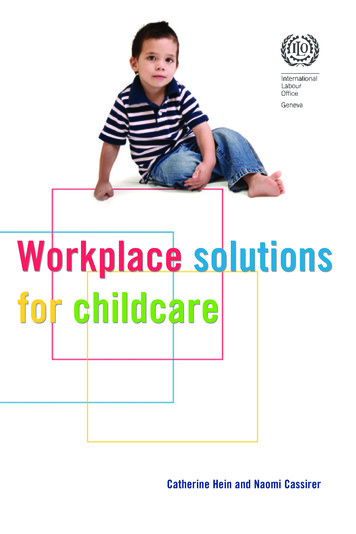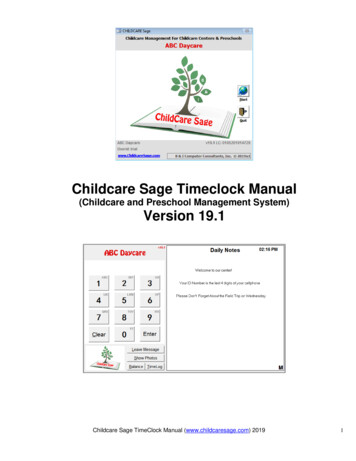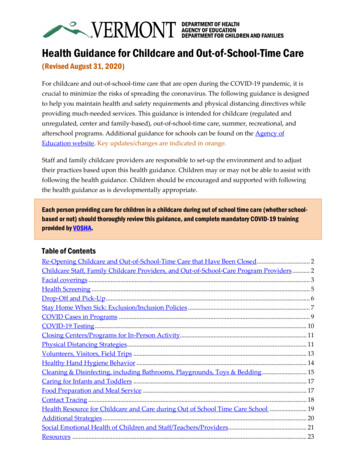
Transcription
Health Guidance for Childcare and Out-of-School-Time Care(Revised August 31, 2020)For childcare and out-of-school-time care that are open during the COVID-19 pandemic, it iscrucial to minimize the risks of spreading the coronavirus. The following guidance is designedto help you maintain health and safety requirements and physical distancing directives whileproviding much-needed services. This guidance is intended for childcare (regulated andunregulated, center and family-based), out-of-school-time care, summer, recreational, andafterschool programs. Additional guidance for schools can be found on the Agency ofEducation website. Key updates/changes are indicated in orange.Staff and family childcare providers are responsible to set-up the environment and to adjusttheir practices based upon this health guidance. Children may or may not be able to assist withfollowing the health guidance. Children should be encouraged and supported with followingthe health guidance as is developmentally appropriate.Each person providing care for children in a childcare during out of school time care (whether schoolbased or not) should thoroughly review this guidance, and complete mandatory COVID-19 trainingprovided by VOSHA.Table of ContentsRe-Opening Childcare and Out-of-School-Time Care that Have Been Closed . 2Childcare Staff, Family Childcare Providers, and Out-of-School-Care Program Providers . 2Facial coverings . 3Health Screening . 5Drop-Off and Pick-Up . 6Stay Home When Sick: Exclusion/Inclusion Policies . 7COVID Cases in Programs . 9COVID-19 Testing . 10Closing Centers/Programs for In-Person Activity. 11Physical Distancing Strategies. 11Volunteers, Visitors, Field Trips . 13Healthy Hand Hygiene Behavior . 14Cleaning & Disinfecting, including Bathrooms, Playgrounds, Toys & Bedding . 15Caring for Infants and Toddlers . 17Food Preparation and Meal Service . 17Contact Tracing . 18Health Resource for Childcare and Care during Out of School Time Care School . 19Additional Strategies . 20Social Emotional Health of Children and Staff/Teachers/Providers. 21Resources . 23
Re-Opening Childcare and Care during Out of School Time that Have Been ClosedTake steps to ensure that all water systems and features (for example, drinking fountains,decorative fountains) are safe to use after a prolonged facility shutdown to minimize the risk ofLegionnaires’ disease and other diseases associated with water.Existing licensed providers do not need to complete lead testing and remediation before reopening after June 1. Only providers now applying for a childcare license are required tocomplete lead testing (and other water tests) prior to opening, consistent with existing CDDregulations. Existing providers will complete testing and remediation as instructed by VermontDepartment of Health Lead Water Testing Program.Childcare Staff, Family Childcare Providers, and Out-of-School-Care Program ProvidersSome individuals are at higher risk of developing severe COVID-19. Among adults, the risk forsevere illness from COVID-19 increases with age. Older adults and those with specificunderlying medical conditions should be encouraged to talk to their healthcare provider toassess their risk and to determine if they should avoid in-person contact in which physicaldistancing cannot be maintained.Based on what we know now , those at higher risk for severe illness from COVID-19 are peopleof all ages with underlying medical conditions, particularly if not well controlled, including, butnot limited to:oooooooChronic kidney diseaseCOPD (chronic obstructive pulmonary disease)Immunocompromised state from solid organ transplantObesity (body mass index [BMI] of 30 or higher)Serious heart conditions, such as heart failure, coronary artery disease, orcardiomyopathiesSickle cell diseaseType 2 diabetes mellitusBased on what we know at this time, a list of conditions for individuals who might be atincreased risk for severe illness from COVID-19 can be found on the CDC’s website. This list iscontinually evolving, so programs and staff should plan to periodically review the list forrevisions and work with their healthcare provider to determine individual risk.For home-based childcare: If a household member has any of the conditions described above,providers should ensure physical distancing (a minimum of 6 feet) between the childcarechildren and the household member, ideally the household member would remain in roomsseparate from the children. Cleaning/disinfecting standards should also be followed, asdescribed below.Health Guidance for Childcare Programs and Out-of-School-Time Care(Revised: August 31, 2020)Page 2 of 24
Facial CoveringsWearing cloth face masks or coverings has been shown to be effective in reducing the risk ofspreading coronavirus. This is because the virus can spread even if a person does not have anysymptoms. All staff must wear facial coverings while providing care. CDC recommends facialcoverings in settings where other physical distancing measures (at least 6 feet) are difficult tomaintain, especially in areas of significant community-based transmission. Adults doing dropoff and pick-up are required to wear facial coverings. Instructions for wearing and makingfacial coverings can be found on the CDC website.Please note on July 24, 2020, Governor Scott issued an Executive Order which requires facialcoverings in public wherever close contact is unavoidable. The Order includes the followinglanguage:For the sake of clarity, the requirements for masks or facial coverings or permitted alternatives inspecific circumstances shall continue to apply as set forth in the following guidance: Phased Restart Work Safe Guidance issued by the Secretary of the Agency of Commerce andCommunity Development (ACCD) permitting limited alternatives to face masks in limitedworkplace settings, as well as some flexibility on use of masks or facial coverings in othercircumstances, such as when eating in a restaurant; Safety and Health Guidance for Reopening Schools, Fall 2020 issued by the Secretary of theAgency of Education (AOE); Health Guidance for Childcare and School Age Camps/Care issued by the VDH, AOEand the Department for Children and Families; (please note that this is this guidance) Guidance to Healthcare Providers issued by the VDH; and Other as set by a designated Secretary or Commissioner, with the approval of the Governor.Facial coverings for children are strongly recommended, with the following guidance: CDC recommends no facial coverings for children under 2-years-old. As such, childrenunder 2-years-old must not wear facial coverings. Parents/caregivers should encourage their children to wear facial coverings upon arrivaland pick-up. Help children understand the importance of wearing facial coverings to prevent thespread of germs Facial coverings are developmentally appropriate when children can properly put on,take off, and not touch or suck on the covering. Children, older than 2-years, who have a medical or developmental reason for notwearing a facial covering should not wear one. These decisions should be made inpartnership with the family and the child’s healthcare provider.Health Guidance for Childcare Programs and Out-of-School-Time Care(Revised: August 31, 2020)Page 3 of 24
Children should not wear facial coverings while sleeping, eating, or swimming (or whenthey would get wet)—encourage physical distancing during these times, as much aspossible. Facial coverings with ties are not recommended for young children as they pose a risk ofchoking or strangulation. Children remove facial coverings during outdoor activities when they can maintainphysical distancing and have ready access to put them back on as needed when activitystops. Please note: Facial coverings are required for children in all programs in schools,including prekindergarten and afterschool programs, as medically anddevelopmentally appropriate. School age children should wear facial coverings whilein childcare or care during out-of-school-time.The following is guidance for childcare providers, staff, teachers: Adults should not wear facial coverings while eating or swimming (or when they wouldget wet). Reinforce physical distancing from children and other adults as much aspossible during these times. Adults may remove facial coverings during outdoor activities when they can maintainphysical distancing and have ready access to put them back on as needed when activitystops. Adults may remove facial coverings indoors for brief periods of time including duringeating and drinking if they can assure 6 feet of distance between children and other staff,to the best of their ability. Child care licensing regulations require staff/providers sit with children while they eat.Health recommendations encourage staff/providers to not eat at the same time aschildren when 6 feet of distance cannot be maintained. Staff may take off their facial covering in select circumstances when physical distancingcannot be maintained, such as when a parent/caregiver is hearing impaired and readslips to communicate. It is also recommended to use facial coverings with clear plasticwindows to support communication when there is ongoing contact with individuals Providers and staff who may consider using clear face coverings include:o Those who interact with children or staff who are deaf or hard of hearingo Providers and staff of children learning to reado Providers and staff of children in English as a second language classeso Providers and staff of children with disabilitiesThe use of clear facial shields for adults that cover the eyes, nose, and mouth is lesspreferable, but allowable. They must meet all of the health guidance of the VermontDepartment of Health. Face shields should extend below the chin and to the earsHealth Guidance for Childcare Programs and Out-of-School-Time Care(Revised: August 31, 2020)Page 4 of 24
laterally, and there should be no exposed gap between the forehead and the shield’sheadpiece. Student should not wear face shields.The following is specific guidance for family childcare providers: Adult household members must wear facial coverings when they are within 6 feet ofchildren in care. The same facial covering requirements apply to children who live in the home aschildren in care, as described above.Health ScreeningPlease note: This is a major change from the previous version.All children (or their parents/caregivers on their behalf) and staff should conduct dailymonitoring for COVID-19 exposure and symptoms. Programs should develop processes toreceive parental/caregiver and staff reports regarding exposure and symptoms. Programs maychoose to ask children and staff to do symptom monitoring at home or prior to entering theschool building. (Note: Family childcare providers are required to conduct this daily healthcheck on themselves before the first childcare child arrives):Children who have arrived from school or children who are arriving via Specialized Child CareTransportation Vendors are not required to have a daily health check, as this would havealready occurred.Exposure is defined as: close contact with a person who has COVID-19 within the last 14 days.Based on our current knowledge, a close contact is someone who was within 6 feet of an infected personfor at least 15 minutes starting from 48 hours before illness onset until the time the patient is isolated.COVID-19 symptoms include the following: CoughFever (100.4 or greater)Shortness of breathChillsFatigueMuscle pain or body achesHeadacheSore throatLoss of taste or smellCongestion or runny noseNausea, vomiting or diarrhea (diarrhea is defined as frequent loose or watery stoolscompared to child’s normal pattern)Childcare and out-of-school-time care should conduct temperature screening of children andstaff. This should occur at the first point of contact. Programs should use the protocol providedHealth Guidance for Childcare Programs and Out-of-School-Time Care(Revised: August 31, 2020)Page 5 of 24
below. If staff conduct temperature screening at home, they should report this informationdaily.Staff or children who have COVID-19 exposure, or signs/symptoms of COVID-19 must notcome to care/program or should be sent home as soon as possible.Temperature check protocol: Temperature checks should occur upon entrance and when possiblenear a sink/hand sanitizer station. A non-contact thermometer is strongly recommended. Wash hands Wear a facial covering, eye protection (goggles* or a face shield), and a single pair ofdisposable gloves. Note: Personal glasses and safety glasses are inadequate. Check each child’s temperature If performing a temperature check on multiple children, ensure that a clean pair ofgloves is used for each child and that the thermometer has been thoroughly cleaned inbetween each check. Remove and discard gloves in between children—if disposable or non-contact thermometersare used and the screener did not have physical contact with a child, gloves do not need to bechanged before the next check. If non-contact thermometers are used, they must be cleaned routinely. Follow instructionsprovided by the manufacturer for any device used. Instructions may include helpful informationsuch as optimal conditions for using the device, calibration if necessary, or proper cleaning andstorage.* Goggles do not need to be airtight but do need to prevent splashes or droplets from landing inthe eye. For this reason, lab goggles with holes are not sufficient.Drop-Off and Pick-Up Signs must be posted at all entrances clearly indicating that no one may enter if theyhave symptoms of respiratory illness. Ideally, the same parent, caregiver or designated person should drop-off and pick-upthe child every day. Parents and designated person should NOT do drop-off or pick-up when:oThey have possible symptoms of COVID-19,oThey are self-quarantining due to close contact with a COVID-19 positiveindividual or travel or awaiting their own COVID-19 test results, and/oro They are isolating because they are currently infected with COVID-19.Consider staggering arrival and drop-off times and/or plan to limit direct contact withparents and designated persons, as much as possible. Hand hygiene stations should be set up at the entrance of the facility or the entranceprocess could be rerouted through a different entrance nearest the sink, so that childrenHealth Guidance for Childcare Programs and Out-of-School-Time Care(Revised: August 31, 2020)Page 6 of 24
can wash their hands before they enter, or immediately upon entry into the facility orchildcare home. Parents and designated persons who are self-quarantining due to close contact with aCOVID-19 positive individual should NOT do drop-off or pick-up. Infants could be transported in their car seats. Store car seats out of children’s reach andin a manner that ensures car seats aren't touching one another. If programs are transporting children:oPrograms must adhere to requirements of group size.oPrograms should space children out in the vehicle to the best of their ability.oDrivers are required to wear facial coverings while transporting children.oAssign seats for children on a bus/vehicle.oCleaning and disinfecting: Practice routine cleaning and disinfecting of frequently touched surfaces,including surfaces commonly touched in the driver’s area of the car. Drivers and monitors/additional adults should wash hands regularly withsoap and water for at least 20 seconds. If soap and water are not readilyavailable, use an alcohol-based hand sanitizer containing at least 60% alcohol. All vehicles must have an adequate supply of hand sanitizer. If there is a known or suspected case of COVID-19 that has been transported,please follow CDC Guidance.Stay Home When Sick: Exclusion/Inclusion PoliciesThe health department encourages all providers and families to coordinate decision makingaround the child’s care with the child’s healthcare provider if there are specific health concerns,chronic disease, or complex social or emotional dynamics in the home.Children who travel to or arrive from out-of-state must follow Agency of Commerce andCommunity Development (ACCD) and Health Department guidance around quarantine beforereturning to childcare and/or out-of-school-time care, which includes travel out-of-state at anypoint during the year. More information is available on the Vermont Department of Health’sCOVID-19 travel site and the ACCD website.Children and staff will be excluded from in-person activities, if they: Show symptoms of COVID-19Have consulted with their healthcare provider about current symptoms, COVID-19testing was recommended, and they are awaiting test results.Have been in close contact with someone with confirmed COVID-19 in the last 14 daysHave a fever (temperature greater than 100.4 F)Health Guidance for Childcare Programs and Out-of-School-Time Care(Revised: August 31, 2020)Page 7 of 24
If above signs and symptoms begin while in care or in your program, the child (or staffmember) must be sent home as soon as possible. Keep sick children separate from well childrenand limit staff contact as much as reasonably possible, while ensuring the safety andsupervision of the sick child(ren) until they leave. If a family childcare provider has any of theabove signs and symptoms, she/he must arrange for children to be picked-up as soon aspossible and keep as much a distance from children while waiting for children to be picked-upas possible. Children and staff must be excluded from care or your program and family childcareproviders should remain closed until they are no longer considered contagious. Thefamily should consult with their child’s healthcare provider. Based on clinical judgment,the child’s healthcare provider will be able to help the family determine what medicalcourse to take (e.g. whether or not they think COVID-19 testing may be necessary). Amedical note is not required for anyone to return to care in cases in which COVID-19 isnot suspected. Children and staff with a fever greater than 100.4 F, no specific diagnosis, and COVID19 is not suspected by the healthcare provider must remain at home until they have hadno fever for a minimum of 24 hours without the use of fever-reducing medications (e.g.,Advil, Tylenol). A family childcare provider who has a fever greater than 100.4 F, no specific diagnosis,and COVID-19 is not suspected by the healthcare provider should remain closed untilthey have had no fever for a minimum of 24 hours without the use of fever-reducingmedications. Materials, toys, and furniture touched by children or staff who are sent home should bethoroughly cleaned and disinfected.oFamily childcare providers and/or staff should protect themselves by wearing anover-large button-down, long sleeved shirt and by wearing long hair up off thecollar in a ponytail or other updo. Those that haven't worn a button-down shirtand who have had close contact with the child sent home, should assess the needto shower and change clothes, depending on proximity of contact.oFamily childcare providers and/or staff should change button-down shirt if thereare secretions on it.oFamily childcare providers and/or staff should wash their hands, neck, andanywhere touched by a child’s secretions.oFamily childcare providers and/or staff should change the child’s clothes ifsecretions are on the child’s clothes, including drool.oContaminated clothes should be placed in a plastic bag or washed in a washingmachine.Health Guidance for Childcare Programs and Out-of-School-Time Care(Revised: August 31, 2020)Page 8 of 24
Healthy children, family childcare providers, and/or staff with the following symptoms/conditions are not excluded from in-person activities: Allergy symptoms (with no fever) that cause coughing and clear runny nose may stay ifthey have medically diagnosed allergies and follow medical treatment plans. Well-controlled asthmaNew symptoms of congestion/runny nose should be excluded and contact the child’shealthcare provider, and not return until no longer contagious.Children with documented allergies or well-controlled asthma do NOT require a medicalclearance note from the child's healthcare provider to attend the program or Family ChildCare Home. However, a child with a new diagnosis of asthma does require writtenconfirmation from the child's healthcare provider.The Health Department is currently drafting symptom and testing protocol to support returnto-care determinations for children with COVID-like symptoms. Once finalized, this will beposted on the Health Department website.Note: If a parent/caregiver or staff member reports symptoms of COVID-19, encourage them tohave a conversation with their healthcare provider to see if they should be tested for COVID-19.The parent/caregiver or staff member can contact 2-1-1 for information on where to access ahealthcare provider if they do not have one. Families who do not have insurance can contactVermont Health Connect for information about affordable insurance options. This also appliesto family childcare providers who have symptoms of COVID-19.COVID Cases in ProgramsIf a family childcare provider, staff person, child, or parent/caregiver has been identified as aclose contact to someone who is diagnosed with COVID-19; they should self-quarantine: stayhome or stay closed in the case of a family childcare provider. This does not include healthcareworkers that are properly using Personal Protective Equipment (PPE). Please refer to the HealthDepartment’s website for what it means to be in close contact and for instructions for isolation,quarantine, and self-observation.If COVID-19 is confirmed in a child or staff member: The person diagnosed with COVID-19 should isolate according to guidelines set forthby the Vermont Department of Health.Open outside doors and windows and use ventilating fans to increase air circulation inthe area.Health Guidance for Childcare Programs and Out-of-School-Time Care(Revised: August 31, 2020)Page 9 of 24
Close off areas used by a sick person (e.g. offices, bathrooms, classrooms, and commonareas) and keep them closed until the area is disinfected according to the followingprotocol:o If possible, wait 24 hours since the person has been in the space before cleaning.Family Childcare Providers should clean the room immediately.o Focus on frequently touched surfaces and shared electronic equipmentEnsure safe and correct use and storage of cleaning and disinfection products, includingstoring products out of reach of children. Follow instructions provided on the product'slabel. Participate in contact tracing as requested by the Health Department. Communicate with staff and parents/caregivers with general information about thesituation. It is critical to maintain confidentiality. Provide the name and contact number of the Primary Contact for the program/childcarecenter to families and staff who may need to provide it when a family (or staff) has apositive COVID-19 case. The Department of Health can use this information to notify theprogram in off hours and share with the contact tracing team.If COVID-19 is confirmed in a child or staff member, work with the Department of Health todetermine next steps. Identification of a child or adult with COVID-19 in the program is not anindication to close the entire program. The Department of Health is developing materials andalgorithms to use with programs to support making decisions on how best to respond.The Health Department has published a flowchart of what happens at the Health Departmentwhen someone tests positive for COVID, which describes this process well.COVID-19 TestingThe Department of Health does not recommend routine COVID-19 testing of providers orchildren. Please visit the Department of Health’s Testing Site to learn more about who shouldget tested and where to get a test. In the event of a case of COVID-19 in a program or FamilyChild Care Home, the Department of Health will identify close contacts and recommend toadministrators/Family Child Care Providers who should be tested for COVID-19Health Guidance for Childcare Programs and Out-of-School-Time Care(Revised: August 31, 2020)Page 10 of 24
Closing Centers/Programs for In-Person ActivityThe decision to close programs or certain classrooms should be made by theadministrator/Family Child Care Provider after consulting with the Department of Health.The Department of Health epidemiologists will provide guidance based on a number of factors,including the level of community transmission, the number of children, providers, staff, orFamily Child Care home household members infected, and other indicators the HealthDepartment uses to assess the status of COVID-19, and the ability of the program or FamilyChild Care Provider to implement infection control strategies.Decisions to close will be determined on a case-by-case basis. If the program is keeping children in a single classroom/cohort/pod, the HealthDepartment recommendation will most likely be to exclude children and staff in theaffected classrooms/cohorts/pod for a minimum of 24 hours while contact tracing isconducted. If multiple classrooms/cohorts/pods are comingling (e.g. during outside time), theHealth Department recommendation will most likely be to exclude children and staff inthe affected classrooms or the entire program or Family Child Care Home for aminimum of 24 hours while contact tracing is conducted.The Health Department will use this time to gather the facts about the situation, including theperiod of time in which the individual was in the program while infectious. The HealthDepartment will convene a rapid response team with administrators/Family Child CareProvider and will initiate the investigation which includes contact tracing. Based on thisinformation, the Health Department will make further recommendations regarding furtherclosure and other infection control measures.Physical (Social) Distancing StrategiesPhysical distancing to reduce the frequency of close contact between individuals is still thesingle most effective way to slow the spread of the coronavirus. General principles to promotephysical distancing and reduce viral spread.An expanding body of scientific evidence continues to support the finding that youngerchildren less than 10 years are least likely to acquire COVID-19 and least likely to transmit toothers when infected, even in very close-contact scenarios, such as within households.Therefore, the added benefits of strict physical distancing in this age group is likely to be farlower than for other age groups. With these considerations in mind, the following guidance isprovided on who should physically distance, and how and when this should occur.Health Guidance for Childcare Programs and Out-of-School-Time Care(Revised: August 31, 2020)Page 11 of 24
Children younger than age 10 should be spaced at least 3 feet apart.As much as possible, adults and adult staff within programs and staff within FamilyChild Care Homes should maintain a distance of 6 feet from one another. Close contact isallowable in cases where there are child health and safety reasons that require two or more staff.To the extent possible, older children (Grade 6 and up) should be spaced 6 feet apart.When physical distancing is not possible, it is even more important for children and staffto adhere to the facial covering requirement, when developmentally appropriate.Please follow childcare and school programs regulations for group size. If Vermont’sdata requires smaller group size than childcare regulations, we will revise. Children coming from school or multiple schools can mix with other children in theprogram/family child care home. Careful attendance records must be kept. Wherever possible, the same childcare and out-of-school-time care staff should remainwith the same group each day. Setup activities at tables 3 to 6 feet apart (depending on children's ages), to the bestextent possible. Plan activities that do not require or that limit close physical contact between multiplechildren, to the best extent possible. L
providing much-needed services. This guidance is intended for childcare (regulated and unregulated, center and family-based), out-of-school-time care, summer, recreational, and afterschool programs. Additional guidance for schools can be found on the Agency of Education website. Key updates/changes are indicated in orange.

